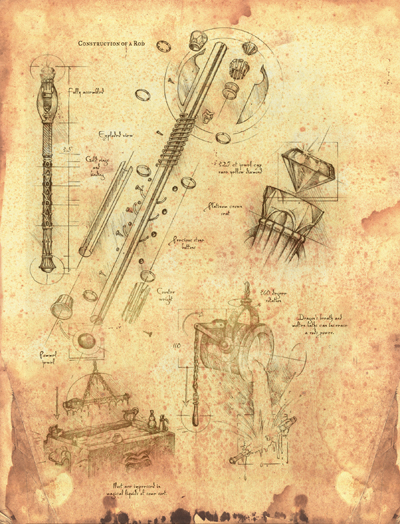Rods,
et
al.
(Including
Staves and Wands)
(III.D.)

Rods,
et
al.
(Including
Staves and Wands)
(III.D.)

|
|
|
|
|
|
|
|
|
Rods, Staves, and Wands |
|
|
|
Descriptions of Magic Items |
|
|
|
|
Rods are about 3 long and as thick as
your thumb.
<weight : 6>
<see below : add weight of case?>
Staves are about 5 or 6 long and as thick
as a young sapling, i.e. about an inch and a half at the
base, tapering to an inch at the tip,
although they can be of nearly equal
diameter throughout, knurled, etc.
<weight : 10>
Wands are <1.5> long and slender.
<weight : 0, but see below>
<bone or ivory case
: 6>
<box : x>
<leather case :
3>
Rods and wands will usually be found in
cases or similar storage places.
Staves stand sturdily alone.
In neither case is concealment precluded,
of course.
Unless noted to the contrary, these items
will have the following number
of charges each time the item is used,
there is an expenditure of 1 charge
(the user will not necessarily be aware
of the number of charges in an
item):
| rods | 50 charges minus 0 to 9 (d10-1) |
| staves | 25 charges minus 0 to5 (d6-1) |
| wands | 100 charges minus 0 to 19(d20-1) |
Most of these items can be recharged by
spell users of sufficiently high
level. This is discussed elsewhere under
the heading FABRICATION OF
MAGIC ITEMS.
Note that a rod, staff or wand completely drained will become
forever useless, crumbling to powder as
its last charge is expended.
Question: In the DMG
it says that rechargeable items can be recharged and yet it says elsewhere
that once they are used up, they cant be recharged.
Please clear this up for
me.
Answer: Any items
that are rechargeable have to have one charge
left in them to be recharged.
To recharge them, you cast spells at
them.
One major problem with such
items is that one is never sure how many
charges they have.
Q. How do you recharge rods, staves and wands?
A. The method of recharging rods etc. is
not clearly stated, so it is up to the
DM to devise a procedure
which is sufficiently expensive/difficult/time-consuming
to
make the act of trying to obtain magic
items by adventuring (the real idea of
AD&D games) at least as attractive
as charging up old ones.
We suggest
that an enchant an item
spell (a 6th level M-U spell)
would be needed, but that the use of
it will be simpler than constructing a
magic item from scratch.
(Imagine #1)
USE of Rods, Staves, and Wands:
Any device of this nature which discharges
some form of magic over a
distance (that is, the device does not
require touch or contact with the
obiect or creature to be affected) must
generally have a command word
spoken in order to cause the device to
function. Thus, a wand of lightning,
for example, might require the utterance
of the key word blitzen in
order to discharge, or it might have a
key phrase to cause it to function,
such as Watt and
ampere, volt and ohm (possibly even extending to:
. . . let this
discharge find its home!). A wand of polymorphing, or
other similar device performing a like
function, would require a key word
and the new form to be made by the power:
Xots the word, be a bird!
or some such. Magical silence will most
certainly prevent such devices
from functioning.
(See also USE OF MAGIC ITEMS, COMMAND WORDS.)
Q: Are rods permanent
items, or do
they have charges?
A: Most rods have
40 + 1dl0 charges when
found (see the DMG,
page 132). Certain
rods (like a rod of cancellation)
have one
charge only.
(147.12)
Unless inapplicable or otherwise specified,
staves function at the 8th level
of magic-use, i.e. their spell discharge
is that of an 8th level of experience
magic-user with respect to range, duration,
area of effect.
The magic functions of a staff generally
require only 2 segments to discharge,
but the device must then build up power
again, and this requires 8
segments.
Damage is nominally 8d6 with respect to
fireballs, lightning bolts, etc.
Wands perform at 6th level of experience with respect to the damage they cause, range, duration, area of effect, etc. unless otherwise stated.
At your option 1 % of all wands are trapped to backfire.
Q: How is a wand,
staff, or rod recharged?
A: The spell-caster
first casts an enchant an
item spell (or its equivalent,
if he isn?t a
magic-user), then recharges
the item by
placing additional spells
into it. You may
give a bonus to the item?s
saving throw
(see the enchant an item
spells description
in the Players Handbook,
pages 83-84),
since wands, staves, and
rods are already
enchanted to hold multiple
spells.
The exact spell that is
needed to recharge
the item will vary with
the type of
item. A wand of fireballs,
for example,
requires fireball spells.
A wand of fire,
however, can create multiple
effects; in
such cases, the spell required
for recharging
is that which is the highest-level
spell
effect that the item creates
(a wall of fire
spell, in the wand of fire?s
case). Some
items create effects that
are unique; for
these, you will have to
decide on a spell or
combination of spells that
approximates
the item?s effect. For example,
shatter or
spiritual hammer might be
used to recharge
a staff of striking, as
these effects
all involve magical force.
Author/designer Jon Pickens
has ap
proached this problem by
creating new
spells to fit some of these
magical items.
The spells have been published
in the
POLYHEDRON? Newszine, the
bimonthly
newsletter of the RPGA?
Network, which
is available only to members
(see
POLYHEDRON? issues #22,
24-26, and 31).
(147.10)